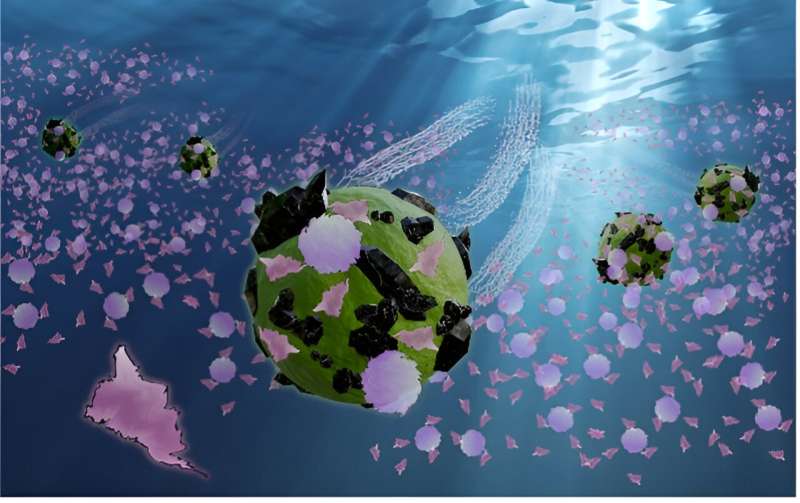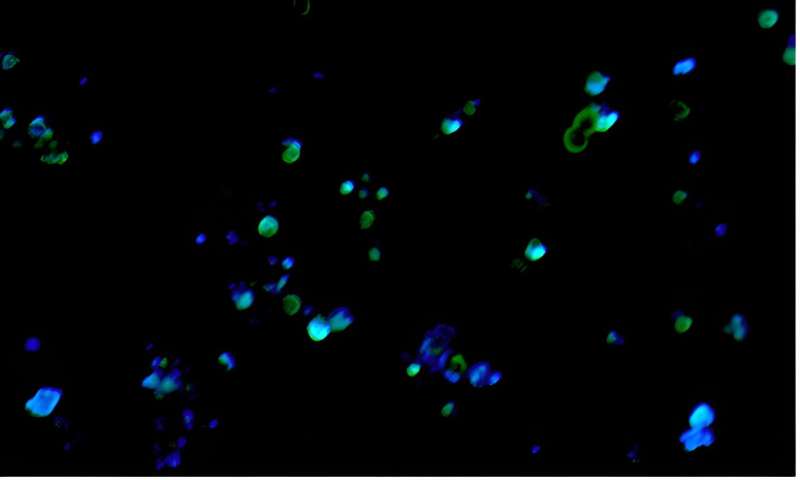November 24, 2023 feature
This article has been reviewed according to Science X's editorial process and policies. Editors have highlighted the following attributes while ensuring the content's credibility:
fact-checked
peer-reviewed publication
trusted source
proofread
Biohybrid microrobots could remove micro- and nano-plastics from aquatic environments

Seas, oceans, rivers, and other bodies of water on Earth have become increasingly polluted over the past decades, and this is threatening the survival of many aquatic species. This pollution takes a wide range of forms, including the proliferation of so-called micro and nano plastics.
As suggested by their name, micro and nano plastics are harmful tiny particles derived from the disintegration of plastic waste released into the water. These particles have been found to disrupt aquatic ecosystems, for instance, delaying the growth of organisms, reducing their food intake, and damaging fish habitats.
Devising effective technologies to effectively remove these tiny particles is of utmost importance, as it could help to protect endangered species and their natural environments. These technologies should be carefully designed to prevent further pollution and destruction; thus, they should be based on environmentally friendly materials.
Researchers at Brno University of Technology and Mender University in the Czech Republic recently developed biohybrid microrobots that could remove micro- and nano-plastics from polluted water without causing further pollution. These robots, presented in a paper published in Advanced Functional Materials, integrate biological materials, specifically algae, with environmentally friendly materials that respond to external magnetic fields.
"Members of our research group have been studying the use of multi-layered TiO2 microrobots for the capture of nano plastics," Xia Peng, co-author of the paper, told Phys.org. "The originally proposed approach involved the incorporation of noble metals, such as Pt, to facilitate propulsion, thereby contributing to an elevated cost and potential hazards associated with the microrobots. To address this issue, we have been exploring the substitution of costly metals with a more economical and readily mass-produced alternative."
The researchers have recently been trying to identify more affordable and environmentally friendly materials for their robots to overcome the challenges encountered in their previous works. Peng particularly started exploring the possibility of using algae cells, which could be easily introduced into marine environments without damaging them.

"The new robots we created, dubbed magnetic algae robots (MARs), consist of a combination of algae and environmentally friendly magnetic nanoparticles," Peng explained.
"These robots operate under the influence of an external magnetic field, enabling precise control over their movement. The negative surface charge of MARs is attributed to the presence of -COOH groups on the surface of algae cells. In contrast, the selected micro/nano plastics carry a positive surface charge. This positive-negative interaction facilitates electrostatic attraction, thereby promoting the targeted capture and removal of micro/nano plastics by the MARs."
The unique composition of the robots created by the researchers makes them both non-polluting and responsive to externally applied magnetic fields. This could allow them to sustainably retrieve nano- and micro-sized plastic particles from aquatic environments.
Peng and her colleagues evaluated their microrobots in a series of tests and found that they achieved remarkable results. In fact, they could be remotely controlled with high levels of precision, removing most tiny plastic particles in the water tanks they were introduced in.
"Our microrobots demonstrated remarkable removal efficiency, achieving a high success rate of 92% for nano plastics and 70% for microplastics," Peng said. "In the future, they could serve as a promising tool for actively removing plastic pollution from water bodies, contributing to environmental remediation efforts, and mitigating the impact of plastic waste on aquatic ecosystems."
In the future, the MARs developed by this team of researchers could be tested and deployed in the sea and other bodies of water, potentially contributing to the removal of toxic plastic residues. Notably, the robots are made using affordable materials and scalable fabrication processes, thus they could be a cost-effective technology to tackle the pollution of aquatic environments.
"Our robots could potentially reduce the need for more resource-intensive and expensive strategies currently employed for plastic waste removal," Peng added.
"Further research could focus on investigating the biocompatibility of MARs with aquatic ecosystems and assessing potential impacts on non-target organisms is crucial for understanding the environmental implications of their deployment. Also, I would also like to investigate how MARs can complement or be integrated with other technologies, such as sensors for real-time monitoring of plastic concentrations."
More information: Xia Peng et al, Biohybrid Magnetically Driven Microrobots for Sustainable Removal of Micro/Nanoplastics from the Aquatic Environment, Advanced Functional Materials (2023). DOI: 10.1002/adfm.202307477
Journal information: Advanced Functional Materials
© 2023 Science X Network




















